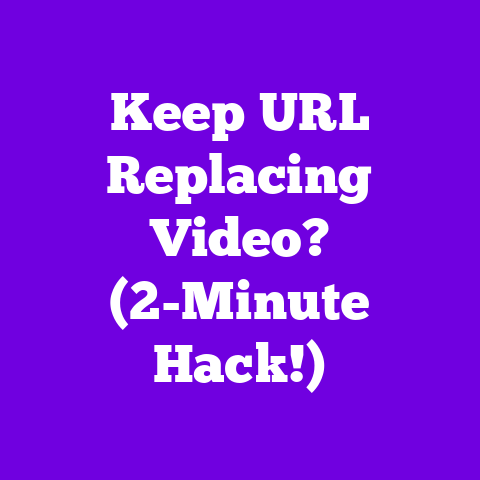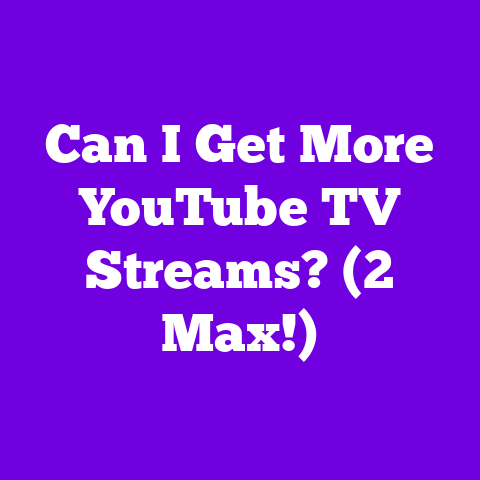YouTube Videos in Presentations? (4-Minute Fix!)
Is it possible to inject that YouTube magic without turning your presentation into a glorified watch party?
How can we strike that balance between entertainment and actual substance in a world that demands constant stimulation?
I’ve been wrestling with these questions myself, and I think I’ve found a pretty solid solution.
Let’s dive into how we can leverage YouTube without losing the core message.
Section 1: The Rise of YouTube as a Learning Tool
Let’s face it, YouTube isn’t just cat videos and vlogs anymore (though I do love a good cat video break!).
It’s become a powerhouse for learning.
Think about it: how many times have you Googled “how to fix a leaky faucet” or “best video editing software tutorial”?
I bet the answer is YouTube almost every time.
The numbers don’t lie.
According to Statista, YouTube has over 2.5 billion monthly active users globally.
A 2023 Pew Research Center study found that 51% of U.S.
adults use YouTube to learn how to do things they’ve never done before.
That’s insane!
The accessibility of content – from coding tutorials to history lessons – has completely changed how we consume and share knowledge.
I’ve personally used YouTube to learn everything from mastering Adobe Premiere Pro to understanding complex economic theories.
It’s a game-changer.
This shift means our audiences are already primed to learn through video.
We just need to tap into that existing behavior effectively.
Section 2: The Challenges of Integrating YouTube Videos into Presentations
Okay, so YouTube is amazing.
We know that.
But just slapping a random video into your presentation isn’t a guaranteed win.
I’ve definitely seen it backfire.
Here’s what we’re up against:
- Technical Gremlins: Ever had the internet cut out mid-presentation?
Or the video just refuse to play?
Nightmare fuel. - Focus Drift: A long, meandering video can easily derail your audience’s attention.
I’ve seen people check out entirely after a poorly integrated clip. - Relevance Fail: If the video doesn’t directly support your point, it’s just filler.
And filler is the enemy of engagement. - Copyright Issues: You need to be mindful of copyright!
Make sure you have the rights to use the video in a public presentation, or you could face legal issues.
I remember one presentation I gave where I tried to show a 10-minute clip from a documentary.
The wifi went down halfway through, and I was left scrambling.
The momentum was gone, and the audience was visibly bored.
It was a hard lesson learned.
We need a strategy to avoid these pitfalls.
That’s where the 4-Minute Fix comes in.
Section 3: The 4-Minute Fix: A Creative Approach to Video Integration
Alright, let’s get to the good stuff.
The “4-Minute Fix” is my go-to strategy for seamlessly weaving YouTube videos into presentations without losing the audience.
Why 4 Minutes?
I’ve found that 4 minutes is the sweet spot.
It’s long enough to showcase a key concept or example, but short enough to maintain attention.
Think of it as a highly concentrated dose of video goodness.
Here’s the rationale:
- Brevity is King: In the age of TikTok and Instagram Reels, our attention spans are shorter than ever.
- Impactful Demos: 4 minutes is plenty of time to show a product demo, explain a process, or highlight a success story.
- Speaker Control: This timeframe allows you to quickly re-engage the audience and reinforce the video’s message.
Step-by-Step Guide:
- Define Your Objective: What specific point do you want the video to illustrate?
This will help you narrow down your search. - Find the Perfect Clip: Search YouTube for videos that align with your objective.
Use specific keywords. - Edit ruthlessly: Use a video editing tool (even YouTube’s built-in editor works!) to trim the video to the crucial 4-minute segment.
- Test, Test, Test: Ensure the video plays smoothly on your presentation setup.
Test the audio and video quality. - Strategic Timing: Place the video at a point where it will have the most impact.
Think about the flow of your presentation. - Contextualize: Before showing the clip, give a brief intro.
Tell the audience what to look for. - Reinforce: After the clip, recap the key takeaways.
Connect the video back to your main argument.
Tips for Maximizing Engagement:
- Use Visual Cues: Add annotations or text overlays to highlight key points in the video.
- Pause and Discuss: Don’t be afraid to pause the video at a critical moment to ask questions or solicit feedback.
- Keep it High-Quality: Choose videos with good audio and video quality.
A grainy, poorly lit video will detract from your message.
I personally use this approach all the time.
I recently gave a presentation on social media marketing, and I used a 3-minute clip from Gary Vaynerchuk discussing the importance of creating authentic content.
It was way more impactful than me just talking about it.
Section 4: Case Studies and Real-World Applications
Let’s look at some real-world examples of how the 4-Minute Fix can be used in different fields.
- Business: A sales trainer uses a 4-minute clip from a sales coaching video to demonstrate effective closing techniques.
After the clip, they break down the techniques and have the audience practice them. - Education: A history teacher uses a 4-minute segment from a documentary to illustrate a key event.
They then lead a class discussion about the historical context. - Technology: A software developer uses a 4-minute demo video to showcase a new feature.
They follow up with a live coding session to show how the feature works in practice. - Marketing: A marketing consultant uses a 4-minute ad campaign video to showcase how a brand successfully connected with their audience.
After the video, they explain how the brand’s message resonated with their target audience.
I’ve noticed that audiences respond really well to this approach.
They appreciate the variety, and they’re more likely to remember the key takeaways.
Section 5: Future Trends: The Role of YouTube in Presentations by 2025
Looking ahead, I think YouTube and other video platforms will become even more integral to presentations.
Here are some trends I’m keeping an eye on:
- Interactive Video: Imagine embedding interactive elements directly into your YouTube videos, allowing viewers to answer questions or take quizzes during the presentation.
Platforms like HapYak already offer similar functionalities. - AI-Powered Video Summaries: AI tools could automatically generate concise summaries of long YouTube videos, making it easier to find the perfect 4-minute segment.
- AR/VR Integration: Imagine using augmented reality to overlay data and information onto a YouTube video during a presentation.
Or using virtual reality to immerse your audience in a virtual environment related to the video. - Personalized Video Recommendations: AI could also suggest relevant YouTube videos based on the audience’s interests and the presentation topic.
- Live Video Q&A: Imagine having live Q&A sessions with the YouTube creator of the videos you include in your presentation.
The possibilities are endless.
As presenters, we need to be ready to embrace these new technologies and adapt our strategies accordingly.
Conclusion: Embracing Change for Effective Communication
The world of presentations is constantly evolving.
The old, static PowerPoint is no longer enough to capture the attention of today’s audiences.
By embracing innovative strategies like the 4-Minute Fix, we can leverage the power of YouTube to create more engaging, informative, and memorable presentations.
I urge you to experiment with video integration in your future presentations.
Don’t be afraid to try new things and see what works best for you and your audience.
Share your experiences and let’s learn from each other.
Together, we can create presentations that truly connect with our audiences and make a lasting impact.
Now go out there and create some awesome presentations!





